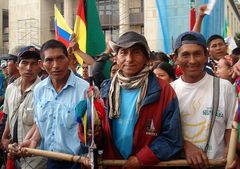article published in the Newsletter ColomPBIa No. 11, May 2009:
PBI spoke to Luis Fernando Arias, a member of the indigenous Kankuamo People, and Secretary General Councillor in the National Indigenous Organisation of Colombia (ONIC), about the human rights situation for indigenous peoples.
How do you view the current human rights situation for the indigenous peoples of Colombia?
LFA: We believe that the situation can only get worse, because of the degradation and dehumanisation of the armed conflict. All of the armed actors use a strategy to involve the civilian population in the conflict, which has led to displacement, persecution and murders.
Currently, which indigenous people are most affected by the armed conflict?
LFA: The Nasa, Kankuamo, Embera, Wiwa and Awa Peoples are the five nations who are most seriously affected by socio-political violence. There are also others who are at risk of physical and cultural disappearance, such as the 18 indigenous peoples who have less than 200 members left. These peoples are disappearing because of the effects of the armed conflict on their lands. Some indigenous peoples are suffering a direct process of extermination by means of murders, massacres and persecution, while others have been exterminated through displacement.
What are the issues of greatest concern to indigenous peoples?
LFA: Militarisation by all the armed actors, and mines in our lands which are threatening our survival. We are in the midst of an extremely dangerous situation for one fundamental reason: indigenous peoples inhabit regions which are highly strategic for economic reasons, and because of the management of the natural resources found there.
How many indigenous peoples are affected by large-scale infrastructure projects?
LFA: Many indigenous peoples are currently being invaded by multinationals. We are carrying out research relating to a number of sectors, including the oil industry and illicit crops, and soon we are going to publish a study on the issue of mining. We published the results of research on the oil industry last year. At this moment in time there are around 750 legally-recognised indigenous territories in the country. According to our study, by the year 2010, 50% of indigenous lands will be invaded by multinational oil companies, not to mention mining companies, agro-fuel companies, hydro-electric companies, and many others. The vast majority of our lands are being exploited by multinationals, and there are also further plans by the multinationals to invade our lands. This means that the issue of multinationals continues to be an imminent risk for indigenous communities. And the experiences we have had throughout the country of the presence of large-scale development projects in our lands have been terrible.
What are the psychosocial effects of the conflict on indigenous peoples?
LFA: Some of the impacts cause irreparable damage from a psychosocial, cultural and spiritual point of view. For example, when an indigenous elder is murdered, we believe that we have lost a whole world of knowledge. When a leader is killed, we believe that we have lost a wealth of knowledge for training future leaders. When a community is displaced, the social and organisational fabric of this community, of indigenous peoples, is completely destroyed. Also, when a sacred place is desecrated, because it has been bombed, for example, there are ways of re-establishing harmony and balance, requiring spiritual and cultural cleansing, respect for the land, and for indigenous authorities. There should be differential attention by the Colombian government, to attend to the particular needs and cosmovisions of indigenous peoples. For this spiritual work we have always used our traditional doctors, and public policy should incorporate these elements. A traditional authority with no qualifications in psychology can deal with these situations using various methods of spiritual cleansing. That is to say, every group of indigenous people has their own method.
What mechanisms exist to prevent the arrival of these companies onto indigenous lands? How effective are they?
LFA: There are political mechanisms, which have been extremely important and have shown concrete results. The Uwa People are one example of this. When the multinational OXY wanted to enter their lands, they held a campaign at the national and international level. Through a process of advocacy and lobbying work, the Uwas built a solidarity movement, and they were finally able to remove the company from their lands. That is one example we should learn from.
The legal mechanisms have been established, within the framework of ILO Convention 169, which sets out the mechanism for prior consultation. However, prior consultation, as applied by the Colombian government, is not a mechanism in which we have the right to say whether or not we agree with a project, it is more a negotiation of the social, environmental, cultural, political and territorial impacts. The Uwas were very wise in this respect, when they said “if we enter into a process of prior consultation, we are implicitly accepting the project”. Prior consultation implies that a decision has already been made, because of the way it is conceived in ILO Convention 169 and the way it has been developed by the Constitutional Court, as there is no right to veto. For this reason, the United Nations Declaration on the Human Rights of Indigenous Peoples goes much further by declaring it necessary to consult indigenous peoples to obtain their prior and free consent. We are not against development, but when a project attacks our ethnic and cultural integrity and places the survival of our peoples at risk; of course we have to say no. For us, life comes before economic and commercial interests.
The Constitutional Court released Decree No. 004 in 2009 to protect the fundamental rights of the displaced indigenous population. Do you believe that this is an important step for the protection of indigenous peoples?
LFA: We believe that Decree 004 reflects to a great extent the socio-political situation that we indigenous people are living through, and that it establishes a scenario which we see as an opportunity to incorporate survival strategies, which need to be adapted to the needs and particularities of indigenous peoples. The plans established by the Decree must incorporate indigenous peoples’ life plans[1] and their proposals for land-use planning.
“Between 1 January 2002 and 31 December 2008, 1244 indigenous people were murdered, which means that every 55 hours an indigenous person is killed in Colombia. The indigenous peoples most affected during this period were the Nasas with 295 assassinations, Kankuamos 198, Wiwas 125, Embera Chami 107 and Awa 93.
According to figures from the National Department of Statistics (DANE), in Colombia there are 87 indigenous peoples, however the ONIC registers 102, which means that there are 15 who have not yet been recognised.”
“La Configuración de un Genocidio Silencioso” ONIC, 2 November 2008
[1] ‘Life plan’ is an indigenous term for the organisation of the whole community and its lands.

